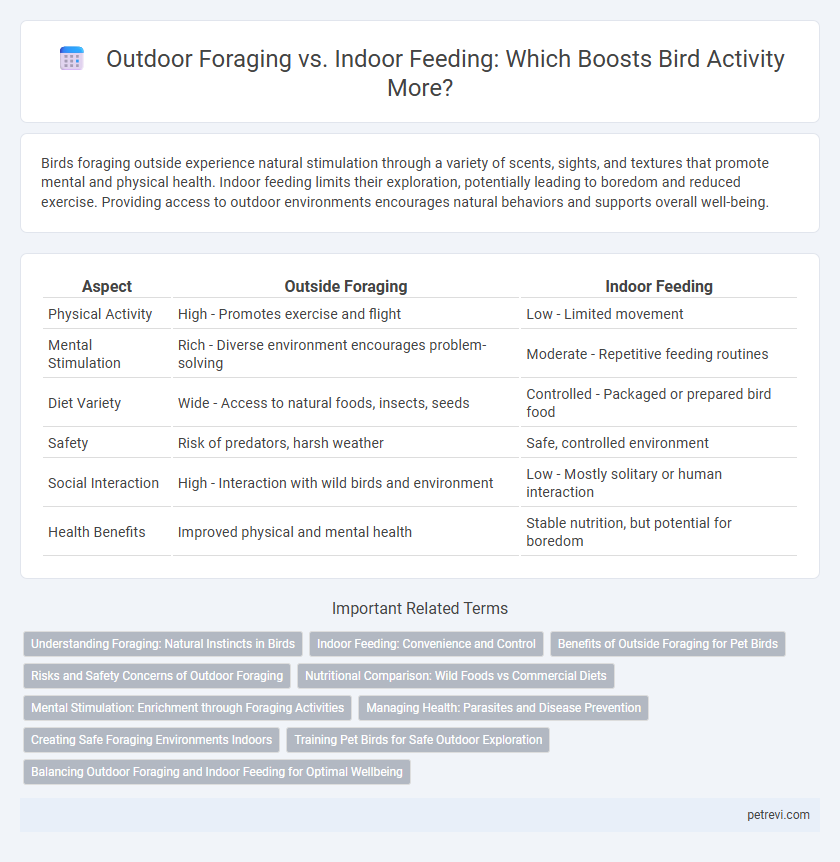Birds foraging outside experience natural stimulation through a variety of scents, sights, and textures that promote mental and physical health. Indoor feeding limits their exploration, potentially leading to boredom and reduced exercise. Providing access to outdoor environments encourages natural behaviors and supports overall well-being.
Table of Comparison
| Aspect | Outside Foraging | Indoor Feeding |
|---|---|---|
| Physical Activity | High - Promotes exercise and flight | Low - Limited movement |
| Mental Stimulation | Rich - Diverse environment encourages problem-solving | Moderate - Repetitive feeding routines |
| Diet Variety | Wide - Access to natural foods, insects, seeds | Controlled - Packaged or prepared bird food |
| Safety | Risk of predators, harsh weather | Safe, controlled environment |
| Social Interaction | High - Interaction with wild birds and environment | Low - Mostly solitary or human interaction |
| Health Benefits | Improved physical and mental health | Stable nutrition, but potential for boredom |
Understanding Foraging: Natural Instincts in Birds
Outdoor foraging stimulates birds' natural instincts by engaging their senses and promoting physical exercise, essential for mental and physical health. Exposure to diverse environments allows birds to exhibit natural behaviors such as searching, hunting, and problem-solving. Indoor feeding often limits these activities, potentially leading to boredom and reduced overall well-being.
Indoor Feeding: Convenience and Control
Indoor feeding offers bird owners convenience by providing a consistent and easily accessible food source, reducing the time and effort spent on daily feeding routines. It allows precise control over diet and nutrition, ensuring birds receive balanced meals tailored to their specific species and health needs. This controlled environment also minimizes exposure to outdoor hazards, promoting safety and well-being for pet birds.
Benefits of Outside Foraging for Pet Birds
Outside foraging for pet birds enhances their physical health and mental stimulation by encouraging natural behaviors such as searching and problem-solving. Exposure to sunlight during outdoor foraging boosts vitamin D synthesis, improving bone strength and immune function. Environmental enrichment from diverse sights, sounds, and smells reduces stress and prevents boredom, leading to overall improved well-being in pet birds.
Risks and Safety Concerns of Outdoor Foraging
Outdoor foraging exposes birds to risks such as predators, toxic plants, and contaminated food sources, which can lead to injury or illness. Environmental hazards like pesticides and pollution also pose significant threats to their health and safety. Ensuring a safe foraging environment requires monitoring local conditions and understanding species-specific dietary needs to minimize exposure to harmful elements.
Nutritional Comparison: Wild Foods vs Commercial Diets
Wild foods consumed during outside foraging provide birds with a diverse range of nutrients, including natural vitamins, minerals, and antioxidants that are often absent or limited in commercial diets. The metabolic benefits of insects, seeds, and fresh fruits support optimal bird health by enhancing immune function and maintaining plumage quality. Commercial diets, while formulated for basic nutritional needs, typically lack the complexity and bioavailability of nutrients found in natural foraging, potentially leading to deficiencies if relied upon exclusively.
Mental Stimulation: Enrichment through Foraging Activities
Outdoor foraging provides birds with diverse sensory experiences and problem-solving opportunities, crucial for mental stimulation and cognitive development. Unlike indoor feeding, which often involves predictable routines, searching for food outside encourages natural behaviors such as exploration and foraging techniques. Enrichment through foraging activities reduces boredom and promotes overall well-being by engaging a bird's instinctual skills.
Managing Health: Parasites and Disease Prevention
Outdoor foraging provides birds with natural dietary diversity that supports robust immune function and reduces susceptibility to parasites and diseases. In contrast, indoor feeding can lead to nutrient imbalances and increased risk of pathogen transmission due to confined spaces and repeated exposure to contaminated food sources. Effective management of bird health involves balancing outdoor access for natural behaviors with regular cleaning of indoor feeders to minimize parasite infestations and disease outbreaks.
Creating Safe Foraging Environments Indoors
Creating safe foraging environments indoors enhances bird activity by mimicking natural behaviors while reducing exposure to outdoor predators and harsh weather. Providing varied textures, hidden treats, and foraging toys encourages mental stimulation and physical exercise, promoting overall well-being. Incorporating non-toxic plants and natural materials further enriches the environment, supporting instinctual foraging instincts safely within the home.
Training Pet Birds for Safe Outdoor Exploration
Training pet birds for safe outdoor exploration enhances their natural foraging instincts while minimizing risks associated with predators and environmental hazards. Controlled outdoor foraging encourages physical exercise and mental stimulation, promoting overall bird health compared to exclusive indoor feeding. Tailored training techniques, including gradual leash adaptation and supervised exploration, strengthen trust and ensure safe interaction with outdoor surroundings.
Balancing Outdoor Foraging and Indoor Feeding for Optimal Wellbeing
Balancing outdoor foraging and indoor feeding enhances bird activity by promoting natural behaviors essential for physical and mental health. Outdoor foraging provides stimulation through varied environments, while consistent indoor feeding ensures reliable nutrition and safety from predators. Combining both methods supports optimal wellbeing by fostering exercise, reducing stress, and maintaining a balanced diet.
Outside foraging vs Indoor feeding for Bird activity Infographic

 petrevi.com
petrevi.com